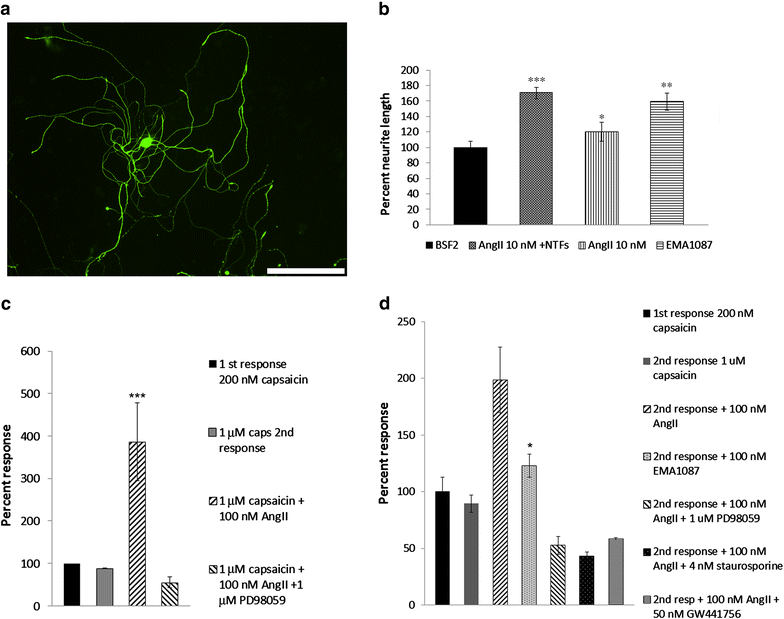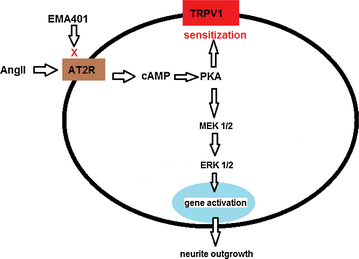Mechanisms underlying clinical efficacy of Angiotensin II type 2 receptor (AT2R) antagonist EMA401 in neuropathic pain: clinical tissue and in vitro studies
- PMID: 26111701
- PMCID: PMC4482278
- DOI: 10.1186/s12990-015-0038-x
Mechanisms underlying clinical efficacy of Angiotensin II type 2 receptor (AT2R) antagonist EMA401 in neuropathic pain: clinical tissue and in vitro studies
Abstract
Background: The clinical efficacy of the Angiotensin II (AngII) receptor AT2R antagonist EMA401, a novel peripherally-restricted analgesic, was reported recently in post-herpetic neuralgia. While previous studies have shown that AT2R is expressed by nociceptors in human DRG (hDRG), and that EMA401 inhibits capsaicin responses in cultured hDRG neurons, the expression and levels of its endogenous ligands AngII and AngIII in clinical neuropathic pain tissues, and their signalling pathways, require investigation. We have immunostained AngII, AT2R and the capsaicin receptor TRPV1 in control post-mortem and avulsion injured hDRG, control and injured human nerves, and in cultured hDRG neurons. AngII, AngIII, and Ang-(1-7) levels were quantified by ELISA. The in vitro effects of AngII, AT2R agonist C21, and Nerve growth factor (NGF) were measured on neurite lengths; AngII, NGF and EMA401 effects on expression of p38 and p42/44 MAPK were measured using quantitative immunofluorescence, and on capsaicin responses using calcium imaging.
Results: AngII immunostaining was observed in approximately 75% of small/medium diameter neurons in control (n = 5) and avulsion injured (n = 8) hDRG, but not large neurons i.e. similar to TRPV1. AngII was co-localised with AT2R and TRPV1 in hDRG and in vitro. AngII staining by image analysis showed no significant difference between control (n = 12) and injured (n = 13) human nerves. AngII levels by ELISA were also similar in control human nerves (4.09 ± 0.36 pmol/g, n = 31), injured nerves (3.99 ± 0.79 pmol/g, n = 7), and painful neuromas (3.43 ± 0.73 pmol/g, n = 12); AngIII and Ang-(1-7) levels were undetectable (<0.03 and 0.05 pmol/g respectively). Neurite lengths were significantly increased in the presence of NGF, AngII and C21 in cultured DRG neurons. AngII and, as expected, NGF significantly increased signal intensity of p38 and p42/44 MAPK, which was reversed by EMA401. AngII mediated sensitization of capsaicin responses was not observed in the presence of MAP kinase inhibitor PD98059, and the kinase inhibitor staurosporine.
Conclusion: The major AT2R ligand in human peripheral nerves is AngII, and its levels are maintained in injured nerves. EMA401 may act on paracrine/autocrine mechanisms at peripheral nerve terminals, or intracrine mechanisms, to reduce neuropathic pain signalling in AngII/NGF/TRPV1-convergent pathways.
Figures






References
-
- Zhang J-M, Strong JA. Recent evidence for activity-dependent initiation of sympathetic sprouting and neuropathic pain. Acta Physiologica Sinica. 2008;60(5):617–627. - PubMed
-
- Smith MT, Woodruff TM, Wyse BD, Muralidharan A, Walther T. A small molecule AngiotensinII type 2 receptor (AT2R) antagonist produces analgesia in a rat model of neuropathic pain by inhibition of p38 mitogen-activated protein kinase (MAPK) and pp44/p42 MAPK activation the dorsal root ganglia. Pain Med. 2013;14(10):1557–1568. doi: 10.1111/pme.12157. - DOI - PubMed
-
- Anand U, Facer P, Yiangou Y, Sinisi M, Fox M, McCarthy T, et al. Angiotensin II type 2 receptor localization and antagonist –mediated inhibition of capsaicin responses and neurite outgrowth in human and rat sensory neurons. Eur J Pain. 2013;17:1012–1026. doi: 10.1002/j.1532-2149.2012.00269.x. - DOI - PMC - PubMed
-
- Rice AS, Dworkin RH, McCarthy TD, Anand P, Bountra C, McCloud PI, et al. EMA401, an orally administered highly selective angiotensin 2 type II receptor antagonist, as a novel treatment for postherpetic neuralgia: a randomised, double-blind, placebo-controlled, phase 2 clinical trial. Lancet. 2014;383(9929):1637–1647. doi: 10.1016/S0140-6736(13)62337-5. - DOI - PubMed
Publication types
MeSH terms
Substances
Grants and funding
LinkOut - more resources
Full Text Sources
Other Literature Sources
Molecular Biology Databases
Miscellaneous

